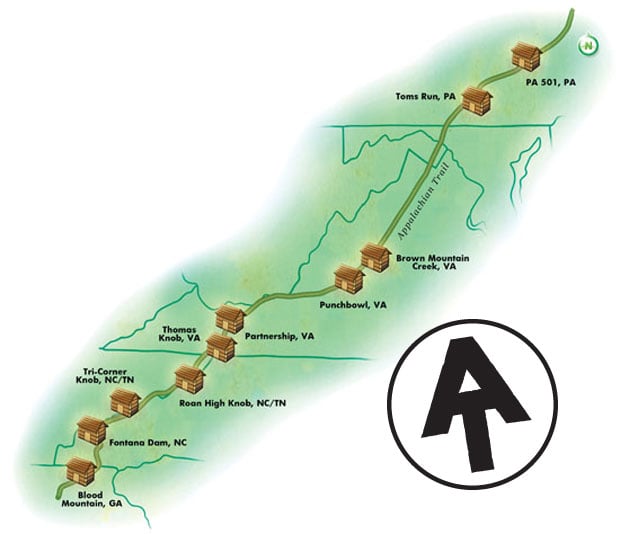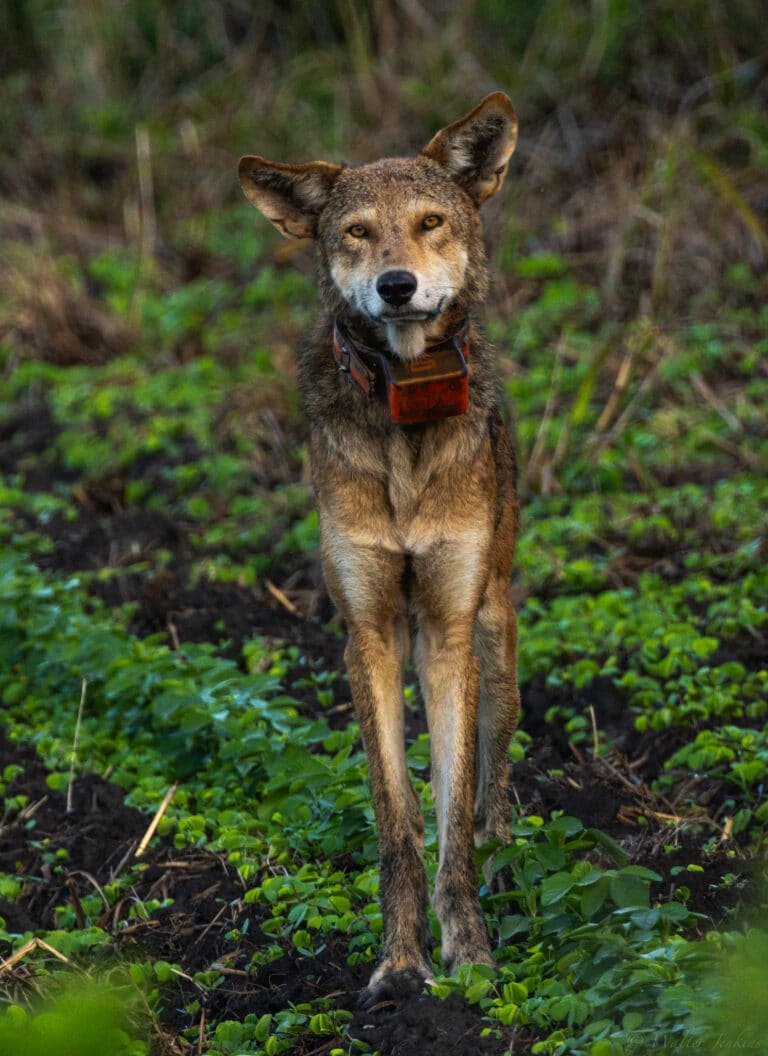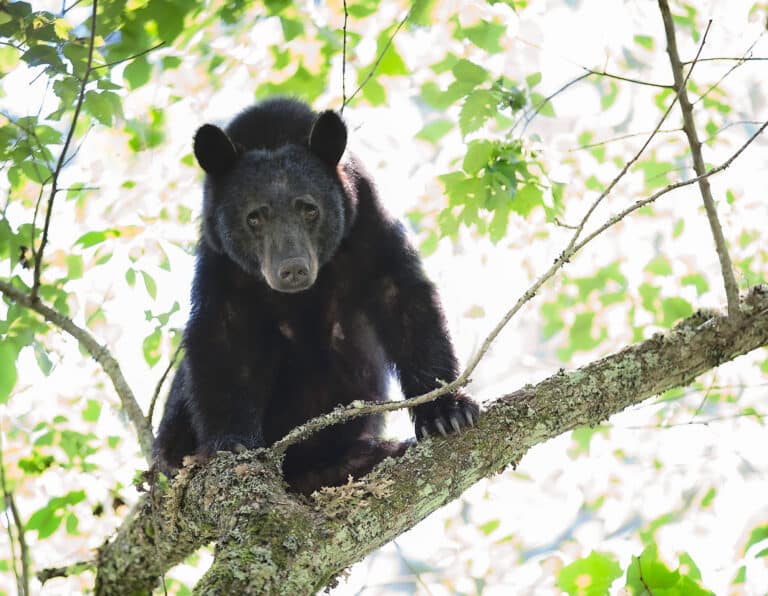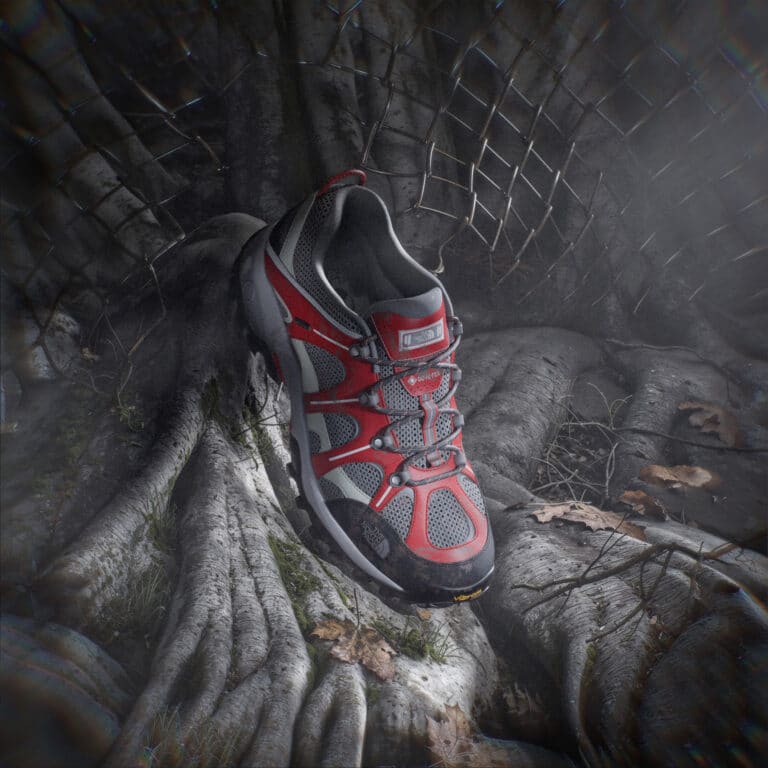The Appalachian Trail is one of the best-known long distance trails in the world—and also one of the most social. The A.T. brings together people of all ages, backgrounds, social circles, religious beliefs, and political persuasions. Amazingly, most of these folks actually get along. They eat together, swap trail stories, and sometimes even sleep inches apart when shelters are crowded. This immediate community is made possible—if not unavoidable—due to the 254 shelters along the trail.
Shelters are the primary congregating spots on the Appalachian Trail. They are three-sided wooden lean-tos that range from shack-like to downright swanky. The A.T. shelters provide refuge in bad weather, they give exhausted backpackers a place to sleep without having to set up their tents, and they are a popular place for day hikers to enjoy a snack. These shelters usually come equipped with a fire ring, picnic table, and hooks or cables for hanging food at night. Most of the time they are conveniently placed beside a water source, and most are stocked with an entertainment device known as the trail register. This hiker journal provides a collection of intriguing and informative narratives from dozens of previous visitors.
When thru-hikers reflect back upon their 2,178-mile journey, some of their most vivid, interesting, scary, and encouraging memories come from just off the trail under the cover of an intimate lean-to. I remember the first night of my thru-hike in 2005. It was freezing outside and the shelter I stayed at was packed past capacity. In the middle of the night the young guy snoring next to me rolled over in his sleep and landed on top of me. He stayed there for the next few hours, and I was actually thankful for the extra body warmth. A week later, I was kept up all night by the chainsaw snoring of a hiker inside the shelter. And here’s the kicker—I was actually tenting 20 yards away. I can’t imagine what it would have been like to sleep next to that man. The wooden floorboards must have been vibrating.
In early April, I was staying at Tri-Corner Knob Shelter in Great Smoky Mountains National Park. The structure is located nearly 6,000 feet above sea level, and 18 miles away from the A.T.’s nearest road crossing. The next morning I awoke and sat up with a rush of fear and adrenaline when I saw a blizzard raging outside. Thankfully, I lived to see another shelter at a lower elevation with less snow on the ground. A few nights later I was sleeping at No Business Knob Shelter, when the only two other inhabitants made me feel extremely out of place with their obscene PDA. Let’s just say, on a scale of affection ranging from hand holding to adult films, it fell closer to the latter.
I had one of my scariest nights on the trail at a lean-to near Damascus, Va., where my fellow inhabitants decided to share ghost stories and tales of A.T. murders as bedtime stories. One hiker decided to repeat the same phrase over and over again, “No, seriously a young female hiker traveling by herself was killed right here.” Way to be sensitive, buddy.
However, tolerating trail stories and sensational hiker lore was far better than spending the night alone in the shelter. When I spent the night alone, that was when my mind took over and I worried all night about a bear coming to find me—or another hiker appearing in the middle of the night.
I was never truly alone in the shelters. I always had plenty of mice to keep me company. I frequently heard them scurry across the rafters and occasionally saw them run across the floorboards. Once they even got into my food bag that was hung beneath the shelter canopy, but that was better than what happened to my trail friend. After a particularly sticky dinner of peanut butter and honey my hiking partner went to sleep and was awakened by a sharp pain in the middle of the night and the teeth of a small gray rodent attached to his finger.
Shelters—for all their downfalls, their dirty hard floorboards, and their unpredictable inhabitants—are still one of the best parts of the Appalachian Trail. They have been part of the footpath’s vision and history since the completion of the trail in 1937. In fact, many of the shelters now rest in wilderness areas that do not allow formal structures, but because the buildings often preceded the wilderness designation, they are exempt and allowed to remain. Some of the oldest shelters were built by the Civilian Conservation Corps and constructed with beams of American chestnut. Most qualify for the National Register of Historic Places.
Shelters reduce the environmental impact of hikers by offering a place to rest other than the lush forest beside the trail. There is also, usually, a well-defined trail leading away from the shelter to a common restroom known as a privy. And if you don’t immediately see the outhouse, or the path leading to it, then follow your nose and you will probably find it. The privies don’t smell good, and sleeping downwind can be an unpleasant experience, but they substantially cut down on the TP flowers and “surprises” around campsites.
The lean-tos also provide a safe refuge with unpredictable weather strikes—literally, they are one of the best places to hunker down in an electrical storm. But beyond providing a haven, and reducing the human impact on the trail, shelters also promote an exchange of ideas. Hikers crossing in opposite directions will tell stories of tough climbs, gorgeous views, dry springs, active bees, and “all you can eat” buffets in an upcoming town. But the discussions at trail shelters often delve deeper than hiking details. Marriages, friendships, and business deals have all been cultivated by the interactions at trail shelters. Strangers become friends and closed minds begin to open, because at an Appalachian Trail shelter you will hear what it is truly like to walk in someone else’s shoes.
10 Unforgettable Shelters:
Blood Mountain
Located 4,458 feet above sea level, Blood Mountain may take its name from a savage battle between the resident Creek and Cherokee peoples, or from the bright red lichen and colorful rhododendron that adorn the mountain. Blood Mountain Shelter is located directly on top of the mountain and is the highest A.T. lean-to in Georgia. The original structure was built out of rock in 1934. It is one of the oldest shelters on the trail. In recent months the structure received a necessary facelift, and no longer shows its age the way it once did. However, one thing that hasn’t changed is the shelter’s awesome view.
Fontana Dam Shelter (aka The Fontana Hilton)
Located near the highest dam east of the Rockies and near the border of Great Smoky Mountains National Park, the “Fontana Hilton” reveals awesome views of Fontana Lake and the surrounding peaks. However, the legacy of this structure is not tied to the location, as much to the highly appreciated amenities. Located 0.3 miles from the Fontana Dam Visitor Center, hikers who stay at this lean-to make use of the hot showers and running water available at the Visitor Center and seasonal shuttles to Fontana Village for food and resupplies.
Tri-Corner Knob
Tri-Corner Knob Shelter sits high on a ridge in Great Smoky Mountains National Park. This lean-to is located approximately 16 miles from both Davenport Gap and Newfound Gap. The location gives this structure the honor of being the shelter located farthest from a road. But be prepared: the high altitude of this shelter makes it especially prone to late spring snowstorms.
Roan High Knob
It is Christmas year-round on top of Roan Mountain. The sweet smell of balsam and fir trees that crown this mountain fill the air with a pleasant holiday scent. Located at 6,285 feet above sea level, this is the highest shelter on the entire Appalachian Trail. The ecosystem and climate at this shelter is rare in the southern Appalachian Mountains and will remind southbound thru-hikers of the peaks in New Hampshire and Maine.
Thomas Knob
If you spend the night at this shelter you may encounter a large, hungry, animal—but it probably will not be a bear. Built on the edge of Grayson Highlands State Park, Thomas Knob Shelter is often frequented by neighboring wild ponies. These hoofed animals have acquired a taste for hiker food. However, they are wild animals and should be observed and respected—not fed. If you have trouble restraining yourself and your snacks, then take your food bag with you and enjoy a walk up the nearby slope of Mount Rogers, the tallest mountain in Virginia.
Partnership Shelter
Hikers know better than to pass up a public restroom with running water. When the employees and guests at the Mount Rogers National Recreation Area Visitor Center finally grew tired of seeing hikers bathing themselves with paper towels and mucking up the clean facilities at the visitor center, they decided to build the hikers their own shelter and restroom with running water. Partnership Shelter is known for its spacious digs, running water, and the ability to order delivery pizza from nearby Marion, Va. However, if you are looking for solitude, look elsewhere. The luxuries of this lean-to, and its proximity to VA 16, make it a popular spot for partiers.
Punchbowl Mountain Shelter
In 1891, a four-year old boy named Ottie Cline Powell became lost while gathering firewood for his schoolhouse. Six months later, little Ottie’s body was found a distant seven miles away near the summit of Bluff Mountain. One reason it took so long to find the young boy’s body is that search teams never imagined a young boy could scale such a difficult and distant mountain. Although the structure did not exist when Ottie went missing, several hikers who have stayed at the nearby Punchbowl Mountain Shelter have reported waking up in the middle of the night and seeing a small boy dressed in colonial garb and crying.
Brown Mountain Creek Shelter
This lean-to is located along the historic Brown Mountain Creek near the remains of a small nineteenth century village occupied by freed African Americans. Freedmen made a living by growing tobacco and corn, and by operating a gristmill along the creek. Descendants remained in this area for the first half of the twentieth century. The heavy underbrush of the late spring and summer make it more difficult to decipher the remains of this settlement, but in the winter it is possible to view the stone ruins of the gristmill and the remains of farming terraces built into the hillside that once made this a vibrant community.
Toms Run Shelters
The first 80 miles of trail in Pennsylvania are some of the most beautiful and level miles on the 2,181-mile path. In the middle of this scenic stretch, the Toms Run Shelters offer two lean-tos for tired hikers. It is rare to have two shelters in the same location. The double shelter prevents overcrowding and preserves the feeling of wilderness in the backcountry. These two shelters are also very close to the ever-shifting halfway point on the trail.
Pa. 501 Shelter
A pleasant respite amid the miles of rocky tread in the middle of Pennsylvania, this is one of a handful of shelters along the Appalachian Trail that is fully enclosed. Not only does this building have four walls, it also has a skylight in the roof—which can provide a memorable display during an electrical storm. Retained by the Appalachian Trail Conservancy and National Park Service when the land was acquired, this shelter also comes complete with a caretaker and a solar-powered shower.
Shelter Etiquette
According to the Appalachian Trail Conservancy
• Shelters are to be filled on a first-come, first-served basis until the shelter is full—so no saving places for your slower hiking partners.
• Shelters are not intended for big groups—troop leaders take note.
• Don’t cut trees or limbs for firewood or vandalize shelter facilities, do carry out all trash—practice Leave No Trace.
• Keep dogs leashed at the shelter and ask the other hikers before allowing Fido inside—yes, I know your dog is special, but this still applies to you.
According to Hikers
• If you snore loudly, carry your tent and set it up away from shelters. Just because you can sleep through the noise doesn’t mean that everyone else will.
• Do not set up your tents inside the shelter. If you want to sleep inside your tent, then camp outside.
• Do not use excessive alcohol or drugs. It can ruin the experience of other hikers.
• Do not talk on your cell phone at a shelter.
• If you want to make out with your significant other, get a tent. And if you are going to sleep naked, stay in your sleeping bag.
• Do not feed the mice (it makes more mice); do not use the trail register as a fire starter; use the privy when provided. Educate yourself about Leave No Trace and practice what you learned.
• Shelters may look like a supersized dog house, but unless your four-legged friend has the ability to stay completely silent and still from dusk to dawn, then do not sleep together inside the shelter.
Shelter “Creep”
Yes, it is possible for there to be a creep at a shelter—and the potential for a shelter to feel creepy—but “shelter creep” is something entirely different. Shelter creep refers to the long-term trend of building larger shelters with more ameni- ties (and often built out of less primitive materials). The Fontana Hilton, Partnership Shelter, and 501 Shelter are good examples of overdeveloped structures.The occasional shower and pizza delivery are a highlight for any backpacker, especially a thru-hiker, but what if every shelter had running water, porch swings, windows, solar lights on the privy trail and direct access to a road? What if every shelter accommodated 30 people or had that fourth wall and a door? Do such shelters detract from a hiker’s interaction with nature?
Jeff Marion, a professor at Virginia Tech, specializes in the study of recreation use in natural areas. He has also spent many years backpacking, studying, and consulting on the management of the Appalachian Trail. He points to an incremental but inexorable “creep” towards ever-larger and more amenity-laden shelters that increasingly promote creature comforts over natural environments. He has worked closely with the Appalachian Trail Conservancy to develop new shelter guidelines, which halt the trend towards larger shelters and promote the use of rustic building designs and materials.








